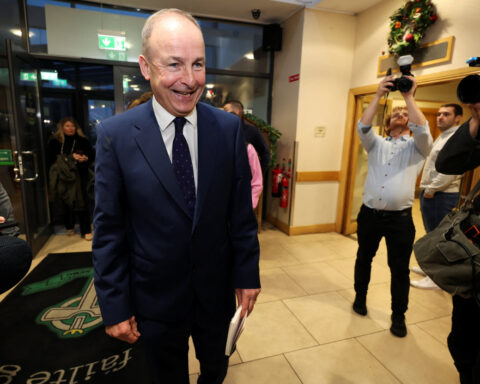By Michael S. Derby
NEW YORK (Reuters) - U.S. total household debt levels rose in the third quarter amid strong growth in credit card borrowings fueled by a hot economy, although there were mounting signs some borrowers are facing increased challenges managing the money they've borrowed, a report from the Federal Reserve Bank of New York released on Tuesday said.
In its quarterly report, the bank said overall debt levels increased by 1.3% during the third quarter to a level of $17.29 trillion. And in that rise, credit card borrowing levels rose by 4.7% to $1.08 trillion, with the bank noting that over the last year there's been a $154 billion increase in these types of balances, the largest since the New York Fed began tracking such data in 1999.
“Credit card balances experienced a large jump in the third quarter, consistent with strong consumer spending and real GDP growth,” Donghoon Lee, a New York Fed economist, said in a press release accompanying the report.
U.S. economic activity in the third quarter took place at a blistering pace few economists expect to be repeated in the final three months of the year. Overall activity rose at a well- above-trend pace of 4.9%, the fastest such gain in two years, in an environment where the Fed was raising interest rates and overall borrowing costs broadly rose.
The surge in borrowing costs has waylaid activity in the housing market amid the highest mortgage rates in decades, and the landscape has fueled worries that many Americans will struggle to manage their debt, especially as high levels of savings during the coronavirus pandemic run down. The New York Fed report found credit issues are rising, albeit from low levels.
STORM CLOUDS
Overall debt delinquency increased by 3% as of September from a 2.6% increase in the second quarter, the report said, while still standing below the 4.7% delinquency rate seen in the fourth quarter of 2019, just ahead of the pandemic’s arrival.
The overall flow of debt moving into delinquency stood at 1.28% in the third quarter, compared with 0.94% in the third quarter of last year. The report said increases in credit card delinquency rates were most pronounced for thirtysomething borrowers.
“The continued rise in credit card delinquency rates is broad-based across area income and region, but particularly pronounced among millennials and those with auto loans or student loans,” the economist noted.
Daniel Silver, an economist with J.P. Morgan, said that in terms of the rising credit issues, "this looks consistent with a softening trajectory for consumer spending, but not a particularly bad one."
In a blog posting that came with the report, New York Fed economists said the rise in credit woes is puzzling given the generally solid state of the economy.
Pinning an explanation on the delinquency rise is “difficult” and “whether this is a consequence of shifts in lending, overextension, or deeper economic distress associated with higher borrowing costs and price pressures is an important topic for further research," the post said.
In comments made on Monday, Fed governor Lisa Cook said she wasn't worried about debt issues on the household level, while noting "of course, we are seeing emerging signs of stress for households with lower credit scores, and individual borrowers may struggle with debt burdens in the face of economic hardships."
The New York Fed report found that overall student loan debt rose by $30 billion to $1.6 trillion in the third quarter. The bank’s data on this type of borrowing arrives after the restart of student loan debt payments, which had been put on hold during the pandemic. The resumption of those payments has been a source of concern, but recent New York Fed research has suggested only modest economic headwinds are likely to result.
Newly created mortgages totaled $386 billion in the third quarter, while the overall level of mortgage balances rose by $126 billion to $12.14 trillion as of the end of September.
The report said auto loan balance were up by $13 billion in the third quarter at $1.6 trillion, “continuing the upward trajectory that has been in place since 2011.”
(Reporting by Michael S. Derby; Editing by Andrea Ricci and Jonathan Oatis)

 Germany sees meat exports to EU continuing after foot-and-mouth case
Germany sees meat exports to EU continuing after foot-and-mouth case
 Parliament speaker to lead Taiwan delegation to Trump's inauguration
Parliament speaker to lead Taiwan delegation to Trump's inauguration
 German economy contracted 0.2% in 2024
German economy contracted 0.2% in 2024
 Middle East latest: Palestinian prime minister says Palestinian Authority should run Gaza in future
Middle East latest: Palestinian prime minister says Palestinian Authority should run Gaza in future
 Nokia signs multi-year patent license agreement with Samsung
Nokia signs multi-year patent license agreement with Samsung
 Irish parties secure 'comfortable majority' for new government
Irish parties secure 'comfortable majority' for new government
 Bayern Munich signs US youngster Bajung Darboe from LAFC
Bayern Munich signs US youngster Bajung Darboe from LAFC
 Novak Djokovic breaks a tie with Roger Federer for the most Grand Slam matches in tennis history
Novak Djokovic breaks a tie with Roger Federer for the most Grand Slam matches in tennis history
 China's RedNote: what you need to know about the app TikTok users are flocking to
China's RedNote: what you need to know about the app TikTok users are flocking to








